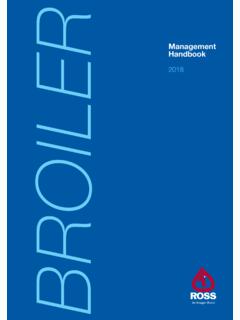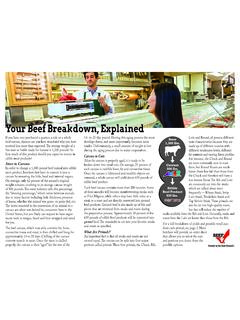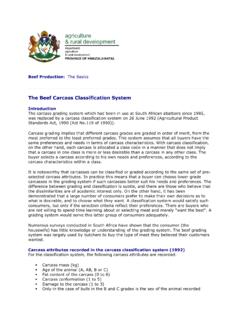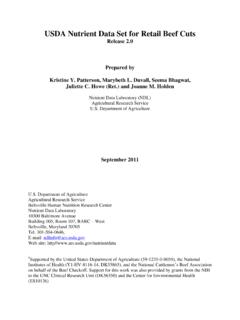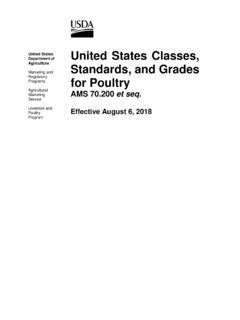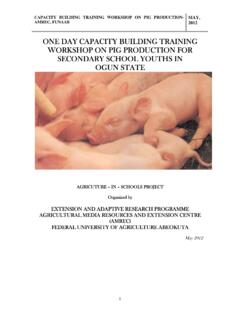Transcription of BROILER - Aviagen | Aviagen
1 Management Handbook2018 BROILER022018 ROSS BROILER MANAGEMENT HANDBOOK: 0202 This HandbookThe purpose of this Handbook is to help Aviagen customers to optimize the performance of their BROILER stock. It is not intended to provide definitive information on every aspect of BROILER stock management, but to draw attention to important issues which, if overlooked, may depress flock performance. The management objectives given in this Handbook have the purpose of maintaining flock health and welfare, and achieving good flock performance both live and through information presented is a combination of data derived from internal research trials, published scientific knowledge and the expertise, practical experience and skills of the Aviagen Technical Transfer and Technical Service Teams.
2 However, the guidance within this Handbook cannot wholly protect against performance variations which may occur for a number of reasons. Aviagen therefore, accepts no ultimate liability for the consequences of using this information to manage BROILER ServicesFor further information on the management of Ross BROILER stock, please contact your local Ross representative or access this HandbookFinding a TopicBlue tabs appear on the right-hand side of the Handbook. These tabs allow readers immediate access to those sections and topics in which they are particularly Table of Contents gives the title and page number of each section and subsection.
3 An alphabetical Keyword Index is given at the end of the Points and Useful Information Supplements to this HandbookSupplements to this Handbook include performance objectives that can be achieved with good management, nutritional, environmental, and health control. Nutrition specifications are also available. All management information can be found online at , by contacting your local Aviagen representative, or by emailing PrefaceKeyPointsUsefulInformationLook for this symbol to find Key Points that emphasize important aspects of husbandry and critical for this symbol to find suggestions for further Useful Information on specific topics in this Handbook.
4 These documents can be found in the Resource Center of the Aviagen website at unless otherwise BROILER MANAGEMENT HANDBOOK: 0303 Section 1 - Introduction5 Introduction7 Stockmanship13 Key Management TimetableSection 2 - Chick Management17 Objective17 Principles17 Introduction18 Chick Quality and BROILER Performance19 Chick ManagementSection 3 - Provision of Feed and Water31 Objective31 Principles31 BROILER Nutrition32 Supply of Nutrients33 Feeding Program34 Feed Form and Physical Feed Quality36 Testing Feed Physical Quality37 Whole Grain Feeding38 Feeding Under Hot Environmental Temperatures38 Environment39 Litter Quality40 Drinking Systems43 Feeding SystemsSection 4
5 - BROILER Nutrition47 Objective47 Principles48 Supply of Nutrients50 Macro Minerals52 Trace Minerals and Vitamins52 Non-Nutritive Feed Additives53 BROILER Diet Specifications54 Designing BROILER Feeding Programs55 Feed Quality57 Feed Processing and Feed Form58 Whole Grain Feeding59 Feeding Under Hot Environmental Temperatures60 Litter Quality61 Welfare and EnvironmentSection 5 - Health and Biosecurity63 Objective63 Principles63 Bird Health and Biosecurity63 Biosecurity72 Decreasing the Risk of Disease74 Disease Investigation77 Disease RecognitionTable of Contents042018 ROSS BROILER MANAGEMENT HANDBOOK.
6 04 Section 6 - Housing and Environment79 Objective79 Principles79 Air80 Water80 Temperature80 Heating80 Housing and Ventilation Systems100 Lighting for Broilers105 Litter Management107 Stocking DensitySection 7 - Monitoring Live Weight and Uniformity of Performance109 Objective109 Principles109 Predictability of Live Weight109 Manual Weighing111 Automatic Weighing Systems112 Inconsistent Weight Data112 Flock Uniformity (CV%)115 Separate-Sex GrowingSection 8 - Pre-Processing Management117 Objective117 Principles117 Preparation for Catching119 Catching123 Transport124 DeliveryAppendices127 Appendix 1 - Production Records129 Appendix 2 - Conversion Tables132 Appendix 3 - Key Performance Parameters135 Appendix 4 - Feather Sexing136 Appendix 5 - Problem Solving138 Appendix 6 - Ventilation Rates and CalculationsKeyword Index141 Keyword IndexTable of Contents052018 ROSS BROILER MANAGEMENT HANDBOOK.
7 IntroductionIntroductionAviagen produces a range of breeds suitable for different sectors of the BROILER market. This allows for the selection of a bird that best meets the needs of a particular operation. All Aviagen chickens are selected for a balanced range of characteristics in both parent stock and BROILER birds. This approach ensures that the birds are capable of performing to the highest standards in a wide variety of environments. characteristics of commercial importance such as growth rate, feed conversion ratio (FCR), livability, meat yield and meat quality are consistently improved with continued genetic advances also being made in bird welfare, leg health, cardiovascular fitness, and of the genetic potential inherent in the birds depends upon making sure that all the factors shown in the figure below are given full and correct attention.
8 All of these are interdependent. If any one element is suboptimal, then BROILER performance will : Factors affecting BROILER growth and s Technical Transfer team has designed this Handbook with the following principles in mind: Consideration of bird welfare at all times. Understanding the elements of the production chain and the transition phases between them. Attention to quality of the end product throughout the entire process. The need for observation of changes in the birds and in their environment. Appropriate management responses to the continually changing requirements of the two BROILER houses are the same, and every flock of broilers will differ in the management needed to meet its requirements.
9 The BROILER farm manager should understand the birds requirements and, through the application of responsive management as described in this Handbook, supply the individual requirements to ensure optimal performance in every supplyVaccination statusHealthFeed supplyLightingVentilationStocking densityChick qualityBird welfareSection 1 - IntroductionSection 1062018 ROSS BROILER MANAGEMENT HANDBOOK: IntroductionEconomic and Commercial IssuesEconomic and commercial issues continue to influence the way broilers are managed, including: An increasing consumer demand for product quality, food safety, and high animal welfare.
10 The need for flocks of broilers which can be grown to ever more predictable and pre-defined specifications. A requirement to minimize variability within flocks and hence variability at processing. An increasing demand for minimizing the environmental impact of BROILER production. Full utilization of the genetic potential available in the bird for FCR, growth rate, and meat yield. Minimization of avoidable diseases such as ascites and leg weaknesses. Maximization of saleable production is only one part of an integrated production chain (Figure ) and therefore should not be considered in isolation.

